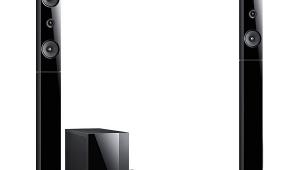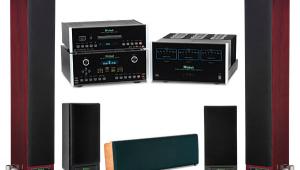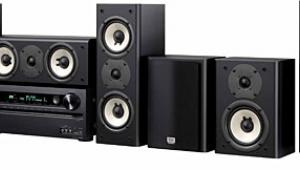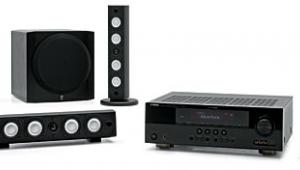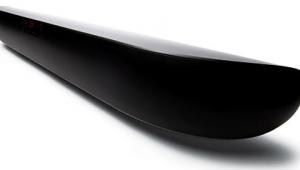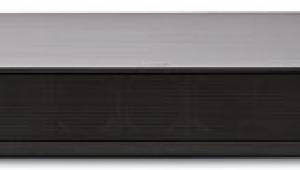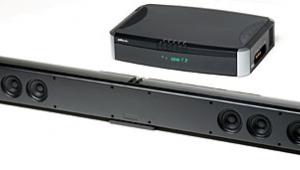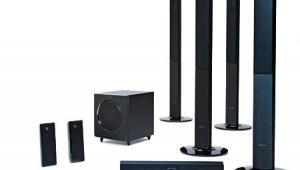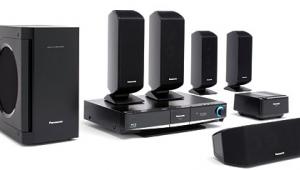ZVOX Z-Base 550 Single-Cabinet Surround System Page 2
Setting up the product is definitively easy. The only hard part will be lifting your TV so that your 10-year-old can slip the Z-Base 550 beneath it. It takes only a few seconds to connect one or both of the stereo inputs. Add a few more seconds to plug in the power cord, with external power supply, and you’re done. There are no setup menus to navigate.
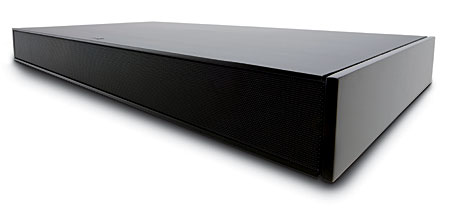
The product operates solely by remote, which could become a problem if you lose the remote. It’s rather tiny, and there are no front-panel controls on which to fall back. The main controls are Volume, Treble, Subwoofer (which adjusts the woofer level), and PhaseCue (which manipulates the surround-like effects). With rare exceptions, I ran all of these in their middle settings, including PhaseCue.
The manual warns of a trade-off between heightened PhaseCue settings and dialogue intelligibility.
 Artful Compromise
Artful Compromise
This product is more about artful compromise than state-of-the-art lossless surround, so all movie selections were DVDs with real-world Dolby Digital 5.1 soundtracks. Remember, the system was connected to the Integra DPS-10.5 universal player’s downmixed two-channel analog output.
Hancock features a flying (and somewhat troubled) superhero, which is just the thing for gauging the extent of surround panning. When Will Smith’s character whooshed from a position between the two surround channels toward the front center channel, his trajectory began about 2 feet in front of the Z-Base 550, moving inward. Tinkling glass in another scene extended 6 inches in front of the screen and a foot or two off to the sides. Effects sounded crisp but felt gentle, evoking the system’s adeptness for dealing with the digital nasties. Low-frequency effects, while not exactly slammin’, were present and controlled enough to convey some of the mixer’s intent. This system is for casual viewing, it’s not for the ultimate home theater experience. Depending on your goals, that may be all you really need.
Baby Mama, the prenatal comedy starring Tina Fey and Amy Poehler, is loaded with a variety of music, including “Stay Up Late” by Talking Heads. The compression of both contemporary music and movie soundtracks can turn a music-rich movie score into a painful succession of botched opportunities. Not so here. It all worked. And the pristinely recorded dialogue showed exactly what the system could do for vocals. It aced them, despite an extremely faint trace of nasality.
Deception, with Hugh Jackman and Ewan McGregor, comes with a largely synth-generated score. Its dreamlike and noirish qualities complement the con-man scenario’s unsettling mood. A scene with brief rainfall showed the system’s limits. In real 5.1-channel surround, well-recorded rain can be a revelation, an incredible mosaic of tiny events. Here, it was not particularly enveloping. But the Z-Base 550 supplied everything else the movie needed in terms of dialogue, the feel of other effects, and musical reproduction.
Plug in the Player
I took ZVOX’s advice and plugged a portable music player into the mixing input. It was not an iPod but a SanDisk Sansa View. I cranked the flea amp all the way up and controlled the volume remotely via the Z-Base.
The Keith Emerson Band’s self-titled debut album has been in heavy rotation around here. I am an unabashed and unreconstructed prog-rock fanatic. Surprisingly, the Z-Base 550 brought out a little more abrasiveness than I’m used to hearing from the same player plugged into a pretty good system—Era speakers and an Onix amp. But I didn’t experiment with other volume settings on the SanDisk to rule out a level mismatch. The production tends to bring out the piano’s treble, at the expense of overall balance, and this became more obvious with the Z-Base 550. It was more revealing than I’d thought during the Dolby Digital movie onslaught. I responded with a strong treble cut via the remote.
I reset the treble to the center position for Bert Jansch’s self-titled debut album, one of the top-ten must-own folk albums of all time. It was recorded in someone’s living room with a borrowed guitar because Jansch’s had been stolen and he was too poor to buy a new one. The production is clean and simple, with relatively modest stereo separation and little reverb or phasey information for the PhaseCue circuit to pick up on. I whacked the control all the way up and all the way down to no particular effect. The result was a slightly closed-in but beautifully intimate listening experience. It probably sounded way better on the Z-Base 550 than it did on the phonographs that most people used in 1966, the year of its release.
The Z-Base 550 produced a credible piano sound with one of my treasures, Bach’s Well-Tempered Clavier as performed by João Carlos Martins for the Connoisseur Society in 1964. Even with the 12-inch 45s converted to MP3, it evoked much of what I’ve loved about the original vinyl. It was limpid, nicely balanced, harmonically rich, reasonably open, and loaded with surface noise. (The person who owned my secondhand set before I got a hold of it was a slob.)
Try It
I tried the system with a 5.1-channel setup sequence from the Avia test DVD, which includes both test tones and voice. I heard the front left and right channels coming from the left and right sides, extending only a few inches in front of and beyond the sides of the Z-Base 550. The front center channel was right where it ought to be. All three front channels were quite vocally solid. The left and right surround channels broke a little farther away from the enclosure, but not by much. They were much more diffuse in tone.

Despite the limits of its surround-like effects, ZVOX’s Z-Base 550 does a lot of things exceptionally well. It handles dialogue better than any soundbar speaker I’ve heard. Bass is modest but lively. The system also makes effects feel right—even if they’re not spatially everything they could be in a conventional surround sound system. This makes even the more aggressive action movies enjoyable, not trying. It also scores high on setup simplicity and ease of use, although a few front-panel controls might help in households with kids, dogs, and absent-minded adults (mea culpa).
All in all, I was impressed by this system. If you’re tired of your TV speakers and want the simplest possible solution with the best sound I’ve heard under those circumstances, this is your ticket.

- Log in or register to post comments
